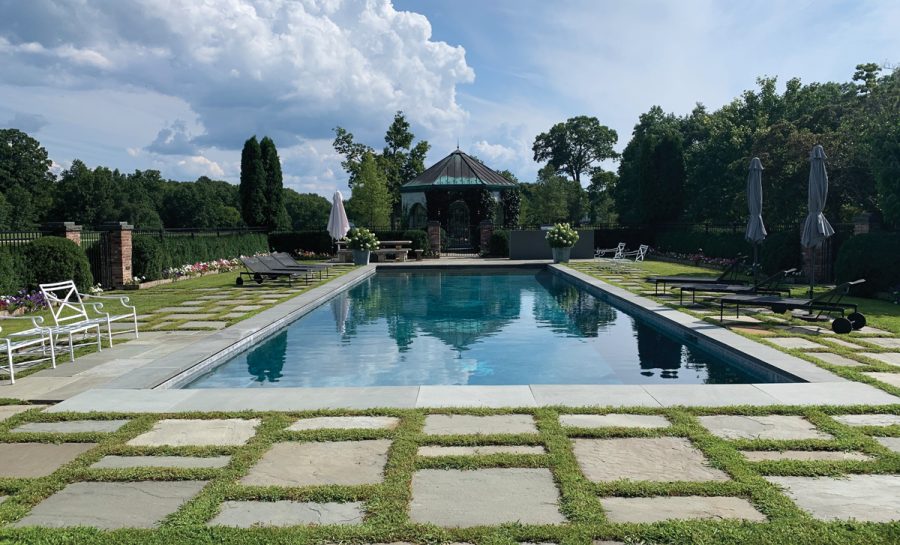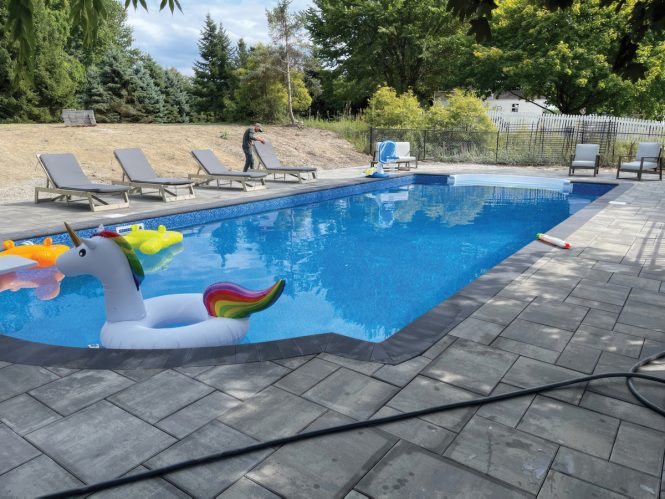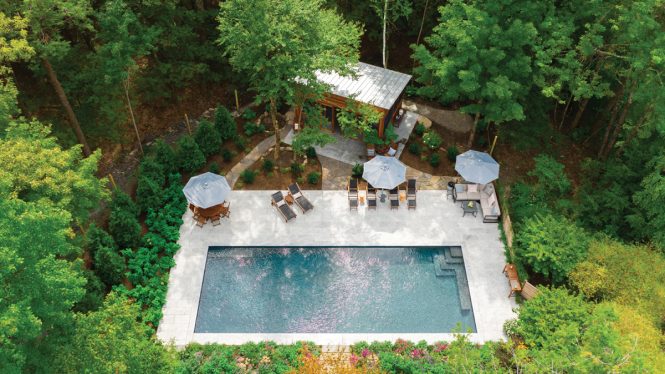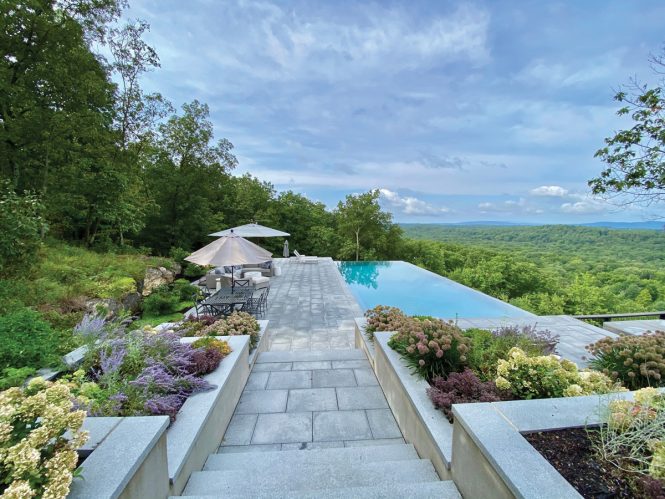In the Swim: Pool-Buying Tips From the Experts
By Staff | Spring 2023 | Features
It’s easy to imagine the allure of an inground pool, of summers spent in your own backyard, enjoying a few laps or floating under sunny skies. However, realizing this vision involves planning on the part of homeowners and making a number of decisions.
The first question that needs to be answered is where to place the pool, a consideration that involves more than aesthetics. Pool placement may depend on the terrain. In the hilly Hudson Valley, even a flat open space can seem ideal until you consider what’s underneath or nearby. “You can’t build an inground pool on top of a leach field or within 35 feet of it,” says Peter Jacobson of Mountain Pools in Woodstock. “So in the Catskills or the Hudson Valley, if you’re not right down in the valley, there’s a lot of varied topography. A lot of homes are built on hillsides and what you’ll often find is that the flat spot near a home on a hillside often is the leach field for the septic tank. Which doesn’t mean you can’t put a pool in. It just means you can’t put it in that open, flat spot. Trees may need to be taken out and the land leveled.”
The final placement may also rely on municipal regulations. “If you have a big piece of land there are rules that say as long as it’s 100 feet from the road, it’s okay,” says Jacobson. “But in more suburban areas, there are more considerations and you may need to get a variance.”
Keep Your Budget in Mind
Before consulting a pool professional, a homeowner may want to calculate how much they want to spend on the project, while recognizing the budget may need adjusting once the site is surveyed and plans are finalized. According to Home Guide it’s possible to construct an inground pool for under $60,000, but an installation is also likely to top $100,000 and even reach $150,000, depending on needed site work and optional features.

A 16-by-30-foot inground vinyl liner swimming pool in Highland designed and installed by Cracolici Inc. and lined with Cambridge Ledgestone smooth pavers.
“In the Hudson Valley, most of our potential customers have a city and country home, or are planning on relocating away from the city to raise their family or retire,” says Justin Scott, vice president of Scott Swimming Pools, based in Woodbury, Connecticut. “We have seen an increase in investment in these homes since 2020 to make the pool and yard areas more all-inclusive since they are going to be getting far more use out of them. Because of this trend, more focus is being put toward the pool area than before. The pool area tends to be closer to the house and contain patios, pool/guest houses and outdoor kitchens, rather than an artistic addition to the property.”
Extra features are optional, but the pool will have to include fencing or a similar safety feature, which is a New York State requirement. An increasingly popular safety option is an electric pool cover, which also reduces heating costs, chemical usage, and as a bonus, covers extend the swimming season.
“If the residence will be occupied longer than the weekends, extending the swimming season is always a consideration,” says Scott. “Considering a well-constructed, top-end, automatically retracting pool cover can extend the swimming season a month on both ends. It will also provide peace of mind if safety fences are extended out of sight from the pool area.”
Care and Maintenance
While a pool can add to the value of a home, a poorly maintained pool will detract from a home’s value. Maintenance is key. In the Hudson Valley, pools need to be closed for the winter and opened again in the spring. As well as having an adequate filtration system, pools require cleaning every other week to remove debris and reduce algae. Operating costs can run between $2,000 and $3,000 a year, so that’s a figure homeowners should consider before a contractor starts digging.

Nejame Pools has been installing pools in the region since 1954, like this luxury model with stone deck and three-season mahogany pool house in Woodstock.
“The cost and appearance of a pool over time depends on the length of use and how the pool is maintained by the homeowner, caretaker, or maintenance company,” says Scott. “If higher-end pebble finishes are used, along with energy-efficient equipment, the pool should hold up against variations in water chemistry care. These upgrades should never be foregone because the pool will maintain its luster even after a season of potentially sub-par pool maintenance.”
Maintenance requirements may depend on the type of pool. “Maintenance will differ depending on the product you pick, whether it’s a concrete, vinyl, or fiberglass pool,” says Chris Nejame of Nejame Pools, based in Dutchess County. “If you do vinyl or fiberglass, you’re going to get a lot less maintenance. Also, if you do a saltwater pool, there’s less maintenance.”
A Koala-Shaped Pool?
Basically, inground pools fall into three categories: fiberglass, vinyl liner, and gunite, which is a concrete blend applied into a mold via a pressure hose. Each has its advantages, so the choice may depend on individual needs and the area’s ecosystem. “Gunite is the most customizable, since it is poured into a mold it can be made into any shape,” says Jacobson. If you’re somebody that wants an infinity-edge grotto and you want your pool to be shaped like a koala, that’s when you need a gunite pool, because there just aren’t going to be kits that have premade wall segments to create that. Vinyl liner is much less customizable than gunite, but much more customizable than fiberglass. With fiberglass, the mold is made in a factory, so homeowners are limited to what’s available.”

An infinity pool by Scott Swimming Pools
For Jacobson, climate and soil type factor in this decision. “It’s not just the freeze-thaw cycle that’s important to consider in the Hudson Valley, but also the nature of our soil,” he says. “We tend to have clay-rich soil, so when clay gets hydrated it expands, and when it dries out, it contracts. Both the expansion and contraction of the clay and also the freeze-thaw puts pressure on the walls of inground pools.”
Fiberglass and vinyl liner pools have some give to them—instead of cracking they flex a bit.
“You’ll see more gunite pools in places that don’t have a freeze-thaw cycle, like Florida and Southern California,” says Jacobson. “You’ll also see more gunite in places that have more sandy soil, like the Hamptons.”
“For the Northeast, I would prefer doing a high-end vinyl liner pool,” says Nejame. “It’s a composite wall that’s engineered for winters with a freeze-thaw cycle.”
A consultation with a pool professional can cover options such as the pool’s ideal shape and what features to incorporate. It’s important to clarify exactly what’s included in the project. Edging around the pool and landscaping may not be considered part of the pool contractor’s project and require a general contractor.
“When developing the pool area, there will be more considerations than just the body of water,” says Scott. “If more than a pool is being constructed, a local general contractor who is familiar with all trades, including carpentry, land forming, and landscaping, should be hired to oversee the total project alongside the pool contractor. This will expedite the project as well as cover any site design issues that may be outside the scope of the pool company’s focus. A good design and implementation usually requires more than one perspective.”
